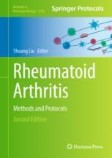Search
Search Results
-
Dental pulp stem cell-derived exosomes revitalize salivary gland epithelial cell function in NOD mice via the GPER-mediated cAMP/PKA/CREB signaling pathway
BackgroundRestoration of salivary gland function in Sjogren’s syndrome (SS) is still a challenge. Dental pulp stem cells (DPSCs) derived exosomes had...

-
The Critical Biomarkers Identification of Insulin Signaling Involved in Initiating cAMP Signaling Mediated Salivary Secretion in Sjogren Syndrome: Transcriptome Sequencing in NOD Mice Model
BackgroundSjogren’s syndrome (SS) is an autoimmune disorder characterized by the destruction of exocrine glands, resulting in dry mouth and eyes....

-
Lack of tumorigenesis and protumorigenic activity of human umbilical cord mesenchymal stem cells in NOD SCID mice
BackgroundThe tumorigenesis of infused umbilical cord mesenchymal stem cells (UC-MSCs) is being preclinically evaluated.
MethodsWe observed tumor...

-
Mutated Pkhd1 alone is sufficient to cause autoimmune biliary disease on the nonobese diabetic (NOD) genetic background
We previously reported that nonobese diabetic (NOD) congenic mice (NOD. c3c4 mice) developed an autoimmune biliary disease (ABD) with similarities to...

-
GPR41 deficiency aggravates type 1 diabetes in streptozotocin-treated mice by promoting dendritic cell maturation
Disturbances in intestinal immune homeostasis predispose susceptible individuals to type 1 diabetes (T1D). G-protein-coupled receptor 41 (GPR41) is a...

-
Humanized Mice as a Model to Assess the Response of Human Hematopoietic Stem Cells to Irradiation
NOD SCID mice were humanized by transplanting human hematopoietic cells isolated from umbilical cord blood. A dose-dependent death of hematopoietic...
-
Towards a better preclinical cancer model – human immune aging in humanized mice
BackgroundPreclinical models are often used for cancer studies and evaluation of novel therapeutics. The relevance of these models has vastly...

-
Simultaneous Administration of NOD-2 (MDP) and TLP-4 (LPS) Ligands to Bone Marrow Donors 24 h before Transplantation Increases the Content of Multipotent Stromal Cells (MSCs) in Bone Marrow Grafts in CBA Mice Compared to the Total Result of Their Isolated Administration
In 3-month bone marrow transplants of CBA mice from bone marrow donors receiving single injections of TLR-4 ligand (LPS) or NOD-2 ligand (muramyl...
-
The Use of Humanized Mice to Understand Arbovirus Pathogenesis
The necessity for realistic animal models of human arbovirus diseases has driven innovation towards systems that represent full, natural transmission...
-
HBB contributes to individualized aconitine-induced cardiotoxicity in mice via interfering with ABHD5/AMPK/HDAC4 axis
The root of Aconitum carmichaelii Debx . (Fuzi) is an herbal medicine used in China that exerts significant efficacy in rescuing patients from severe...

-
Inhibition of NLRP1 inflammasome improves autophagy dysfunction and Aβ disposition in APP/PS1 mice
Increasing evidence has shown that the NOD-like receptor protein 1 (NLRP1) inflammasome is associated with Aβ generation and deposition, which...

-
NOD-like receptor NLRC5 promotes neuroinflammation and inhibits neuronal survival in Parkinson’s disease models
Parkinson’s disease (PD) is mainly characterized by the progressive degeneration of dopaminergic neurons in the substantia nigra pars compacta (SNpc)...

-
Mice as Experimental Models for Cancer Research
Cancer is a devastating disease affecting a large number of people worldwide. There has been relentless effort to learn various aspects of the...
-
Hesperetin attenuates cognitive dysfunction via SIRT6/NLRP3 pathway in scopolamine-induced mice
Neuroinflammation is a critical feature in the pathogenesis of neurodegenerative disorders such as Alzheimer’s disease (AD). Hesperetin can exert...

-
Generation, evolution, interfering factors, applications, and challenges of patient-derived xenograft models in immunodeficient mice
Establishing appropriate preclinical models is essential for cancer research. Evidence suggests that cancer is a highly heterogeneous disease. This...

-
Novel insights into NOD-like receptors in renal diseases
Nucleotide-binding oligomerization domain-like receptors (NLRs), including NLRAs, NLRBs (also known as NAIPs), NLRCs, and NLRPs, are a major...

-
Orthotopic PDX and CDX Mice Model for Cancer Stem Cell Research
The advancement of cancer research definitely enlightened the survival of cancer patients in the United States; however, more translation and...
-
Differential pulmonary toxicity and autoantibody formation in genetically distinct mouse strains following combined exposure to silica and diesel exhaust particles
BackgroundInhalation of airborne particulate matter, such as silica and diesel exhaust particles, poses serious long-term respiratory and systemic...

-
Human Xenograft Model
Human-SCID grafting is a commonly used technique for the long-term investigation of rheumatoid arthritis (RA) explants. To establish a chimeric...
-
NLRP3–GABA signaling pathway contributes to the pathogenesis of impulsive-like behaviors and cognitive deficits in aged mice
BackgroundPerioperative neurocognitive disorders (PND), such as delirium and cognitive impairment, are commonly encountered complications in aged...

